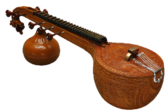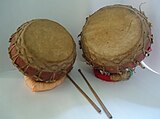Vadya
Vadya (Sanskrit: वाद्य, vādya), also called vadyaka or atodya, is one of the three components of sangita (musical performance arts), and refers to "instrumental music" in the Indian traditions.[1][5][6] The other two components of sangita are gita (vocal music, song) and nritya (dance, movement).[1][7][4] In the general sense, vadya means an instrument and the characteristic music they produce, sound, or play out.[8][9]
The term vadya in the sense of "music, sounded, played, uttered" appears in Vedic literature such as the Aitareya Brahmana, and in early post-Vedic era Sanskrit texts such as the Natya Shastra, Panchatantra, Malvikagnimitra, and Kathasaritsagara.[5] These texts refer to the musician or instrumental performer as vadyadhara.[5] A stringed instrument is described with proportional lengths in Jaiminiya Brahmana and Aitareya Aranyaka, and these are compared to poetical meters.[10] The 17th-century text Sangita Darpana defines sangita (musical arts) as "gītam vādyam tathā nrityam trayan sangīta muchyate", meaning sangita comprises gīta (vocal music), vādya (instrumental music), and nritya (dance).[11]
Classification of instruments
Sanskrit literature describes four types of vadya:[4][6][12]
- Tantu: stringed musical instrument (chordophone)
- Susira: hollow musical instrument (aerophone)
- Ghana: solid musical instrument (idiophone)
- Avanaddha: covered musical instrument (membranophone)
Ensembles and orchestras
The chapter 14 of the Saṅgītaśiromaṇi describes musical ensembles based on a collective performance of vadya instruments by musicians, and it calls such a band orchestra as a kutapa.[13]
The term vadya also appears in the Buddhist Sanskrit text Sukhavativyuha, influential in the Chinese and Japanese traditions, which Luis Gomez translates as "instrumental music".[14]
In Hindu-Javanese music tradition, vadya is called vaditra.[7] According to Roger Blench, most scholars consider the term valiha (a Madagascar tube zither instrument) to be rooted in the Sanskrit term vadya, reflecting a period of cultural exchange over the Indian Ocean.[15]
- Lewis Rowell (2015). Music and Musical Thought in Early India. University of Chicago Press. p. 13. ISBN 978-0-226-73034-9.
- Bigamudre Chaitanya Deva (1995). Indian Music. Taylor & Francis. pp. 95–96. ISBN 978-81-224-0730-3.
- Rachel Van M. Baumer; James R. Brandon (1993). Sanskrit Drama in Performance. Motilal Banarsidass. pp. 117–118. ISBN 978-81-208-0772-3.
- Alison Arnold; Bruno Nettl (2000). The Garland Encyclopedia of World Music: South Asia : the Indian subcontinent. Taylor & Francis. pp. 19–20. ISBN 978-0-8240-4946-1.
- Monier Monier-Williams, Sanskrit-English Dictionary with Etymology, Oxford University Press, page 940
- Dilip Ranjan Barthakur (2003). The Music and Musical Instruments of North Eastern India. Mittal Publications. pp. 3–4. ISBN 978-81-7099-881-5.
- Jaap Kunst (2013). Hindu-Javanese Musical Instruments. Springer Science. pp. 88 with footnote 26. ISBN 978-94-011-9185-2.
- Lewis Rowell (2015). Music and Musical Thought in Early India. University of Chicago Press. pp. 113–114. ISBN 978-0-226-73034-9.
- Mandakranta Bose (2012). Movement and Mimesis: The Idea of Dance in the Sanskritic Tradition. Springer Science. p. 57. ISBN 978-94-011-3594-8.
- Emmie te Nijenhuis (1992). Saṅgītaśiromaṇi: A Medieval Handbook of Indian Music. BRILL Academic. pp. 12–14. ISBN 90-04-09498-9.
- Dona, Lasanthi Manaranjanie Kalinga (2012). "On the Therapeutic Aspects of Indian Classical Music". Musik-, Tanz- und Kunsttherapie. 23 (1). Hogrefe Publishing: 8–14. doi:10.1026/0933-6885/a000069.
- Bonnie C. Wade (1987). Music in India: The Classical Traditions. Riverdale Company. p. 88. ISBN 978-0-913215-25-8.
- Emmie Te Nijenhuis (1992). Saṅgītaśiromaṇi: A Medieval Handbook of Indian Music. BRILL Academic. pp. 524–525. ISBN 90-04-09498-9.
- Luis Gómez (1996), The Land of Bliss: Sanskrit and Chinese Versions of the Sukhāvatīvyūha Sutras, University of Hawaii Press, ISBN 978-0-8248-1760-2, page 72 (verse 28.23)
- Roger Blench (2014), Using Diverse Sources of Evidence for Reconstructing the Past History of Musical Exchanges in the Indian Ocean, African Archaeological Review, Volume 31, Issue 4 (December), pp 675–703



